From this French-American singer-songwriter’s fourth studio album, Half the Perfect World, released in 2006:
April 2017
Fri 14 Apr 2017
Music I’m Listening To: MADELEINE PEYROUX “The Summer Wind.”
Posted by Steve under Music I'm Listening To[4] Comments
Thu 13 Apr 2017
A Movie Review by Jonathan Lewis: THE NIGHT VISITOR (1971).
Posted by Steve under Horror movies , Reviews[2] Comments
THE NIGHT VISITOR. Universal Marion Corporation, 1971. Max von Sydow, Trevor Howard, Liv Ullmann, Per Oscarsson, Rupert Davies, Andrew Keir. Director: László Benedek.
Before there was such a thing as the slasher film genre, there was The Night Visitor. Directed by László Benedek (The Wild One), this English-language Swedish film is a brooding psychological thriller, albeit one punctuated by moments of extreme, brutal violence. Set in a small, somewhat isolated Swedish town beset with winter snow, the story follows the devious scheme hatched by Salem (Max Van Sydow in an standout performance), an inmate at an asylum for the criminally insane, to wreak havoc and to exact revenge on those who framed him for a crime he did not commit.
Salem isn’t a particularly bright man, but he’s devised an ingenious, if highly implausible, method to escape from his cell at the asylum. He does so in such a methodical and successful manner that he is able to leave his cell, abscond into the Swedish landscape, and to avenge himself upon those who he — rightfully — believes have wronged him two years ago when he was framed for the murder of a farmhand. When he returns to his cell, however, he has an iron-clad alibi.
Among Salem’s targets are his sister Ester (Liv Ullmann), and her husband, Anton (Per Oscarsson). He also targets three other people: Anton’s sister, his former lover, and the lawyer who was bribed into changing Anton’s plea into not guilty by reason of insanity.
Once bodies start showing up in his small town, the local police inspector (Trevor Howard) begins to investigate whether it is just possible that Salem is the one committing the crimes after all. But he’s not entirely convinced that Anton is innocent either. Howard is nearly flawless in his portrayal of an elderly, somewhat cynical, policeman who isn’t so easily impressed by or intimidated by any one who comes between him and his quest for the truth.
Overall, The Night Visitor isn’t a superb movie, but it’s a good one. The tension is palpable throughout and the stark, wintry Scandinavian landscape lends the film an atmosphere that is hard to beat. Although one may end up finding Salem’s nearly magical escape methods to be somewhat laughable, the movie’s bleak, brooding nature makes up for whatever implausible plot devices are utilized to tell the story of a man who literally went crazy when he was unjustly imprisoned in an asylum.
Thu 13 Apr 2017
A 1001 Midnights Review: DOLORES HITCHENS – Sleep with Slander.
Posted by Steve under 1001 Midnights , Reviews[5] Comments
by Bill Pronzini
DOLORES HITCHENS – Sleep with Slander. Doubleday Crime Club, hardcover, 1960. Permabook M-4243, paperback, 1962; Berkley, paperback, 1969.
Many people seem to feel that the best hard-boiled male private-eye novel written by a woman is Leigh Brackett’s No Good from a Corpse (reviewed here ). But that may because many people haven’t read Sleep with Slander. For the undersigned reviewer’s money, this is the best hard-boiled private-eye novel written by a woman — and one of the best written by anybody.
Its protagonist, Long Beach-based Jim Sader, is a multidimensional character, much more realistic than the stereotypical tough detective; Sader uses his intelligence to accomplish his purposes. The plot, reminiscent in its complexity of both Chandler and Ross Macdonald, is better crafted, more compelling, and ultimately more satisfying than the Brackett.
Sader is hired by a rich old man, Hale Gibbings, whose daughter gave birth to an illegitimate child five years earlier. The child, Ricky, was given away for adoption, not through a recognized agency but to a private couple, and Gibbings has heard nothing about the boy until recently, when an anonymous letter writer tells him the child is being mentally and physically abused.
Sader undertakes the search for Ricky, following a trail that leads him to a conniving friend of Tina Champlain, the adoptive (and now presumed dead) mother; to a violent builder of boats and his drunken father; to murder, extortion, double-dealing, madness; and finally to the truth. The surprises Hitchens springs along the way are not at all easy to anticipate. A first-rate novel recommended not just to fans s of the hard-boiled school but for anyone who appreciates a quality mystery.
Hitchens wrote one other novel featuring Sader: Sleep with Strangers (1957). This is also good reading, but marred by sentimentality and a shaky ending that reveals the wrong choice of murderer.
———
Reprinted with permission from 1001 Midnights, edited by Bill Pronzini & Marcia Muller and published by The Battered Silicon Dispatch Box, 2007. Copyright © 1986, 2007 by the Pronzini-Muller Family Trust.
Wed 12 Apr 2017
A 1001 Midnights Review: LEIGH BRACKETT – No Good from a Corpse.
Posted by Steve under 1001 Midnights , Reviews[2] Comments
by Bill Pronzini
LEIGH BRACKETT – No Good from a Corpse. Coward McCann, hardcover, 1944. Dennis McMillan, hardcover, 1998 [includes eight detective pulp stories plus title novel]. Reprint paperbacks: Handi-Book #32, 1944; Collier, 1964.
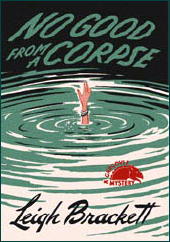
Leigh Brackett is perhaps best known for her science fiction and for her script work on the classic private-eye film The Big Sleep (1946); but she also wrote excellent crime fiction (and one very good historical western). Her mysteries tend to be tough-minded and realistic. No Good from a Corpse, in fact, can accurately be termed “hard-boiled” — and indeed has been called, by some critics and aficionados, the best traditional private-eye novel written by a woman.
Los Angeles detective Edmond Clive embarks on an angry, vengeful hunt when an old girlfriend, nightclub singer Laurel Dane, is murdered. His quest leads him from Beverly Hills mansions to cheap night spots along the Sunset Strip; from rich playboys (and playgirls) to denizens of the underworld; from threatening telephone calls to a knock on the head to attempts on his fife; and from blackmail to several more murders before he finally uncovers the not altogether surprising identity of Laurel’s murderer and the truth behind a web of lies and half truths.
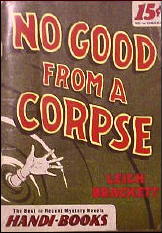
Critic Anthony Boucher stated in an introduction to a reissue of this novel in 1964 that Bracken was the one woman who “most successfully captured the authentic Chandleresque male tone.” True enough; the tone is very Chandleresque, to the point of pastiche. It is as if Miss Brackett deliberately set out to out-Chandler Chandler.
About the novel itself, Boucher wrote, “Its ingredients are not startlingly new: it even includes the obligatory night clubs, in which detective-story characters spend so much more time than any other class of people. But the familiar ingredients take on fresh life, partly because Miss Brackett looks at and writes about Los Angeles itself and not its conventionalized fiction image.”
Also true, pro and con. There is nothing really new in the novel; Brackett covers old ground- and covers it well, even expertly, but the fact remains that Chandler did it first and did it better. Clive is the only memorable character,and he pales alongside Philip Marlowe. With all due respect to Boucher and the book’s other boosters, No Good from a Corpse is not the best traditional male private-eye novel written by a woman. That distinction belongs to Dolores Hitchens’s Sleep with Slander (reviewed here ).
———
Reprinted with permission from 1001 Midnights, edited by Bill Pronzini & Marcia Muller and published by The Battered Silicon Dispatch Box, 2007. Copyright © 1986, 2007 by the Pronzini-Muller Family Trust.
Tue 11 Apr 2017
Stories I’m Reading: DASHIELL HAMMETT “The Tenth Clew.”
Posted by Steve under Pulp Fiction , Stories I'm Reading[5] Comments
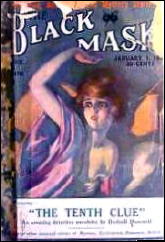
DASHIELL HAMMETT “The Tenth Clew.” Continental Op short story #6. First published in Black Mask, January 1, 1924. Reprinted in Ellery Queen’s Mystery Magazine, July 1945; revised ending. Also, among others: The Return of the Continental Op (Jonathan Press #J17, paperback, 1945; Dell #154, paperback, 1947); The Continental Op (Vintage V-2013, paperback; November 1975; edited by Steven Marcus); all with the original ending.
“The Tenth Clew” (or “Clue,” as it is on the front cover of the magazine) is the lead story of the latter collection, which I happened to notice in a box of paperbacks I was going through and decided to read. It’s been a while since I read anything by Hammett, and long since time, I decided, that I should.
I’d forgotten, though, that Mike Nevins had made a point of talking about this story in his June 2011 column for this blog. When I got to the end of what was otherwise a very enjoyable story, I was taken aback and asked myself what it was that I’d missed.
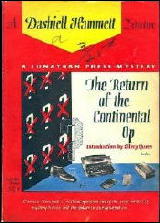
It turns out that it was a major mistake by Hammett and his editor way back in 1924, one that Fred Dannay fixed when he ran the story in EQMM some twenty years later, but then reverted back to the original ending most if not all of its appearances since.
Since Mike did such a good job in discussing it, I won’t talk about it here, as I’d intended to. Go read about it in that old column of his, then by all means come back. Let me talk about this instead.
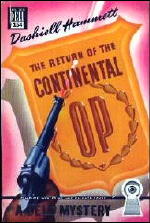
I don’t claim that the thought is original to me, and I’m sure it isn’t, but it’s worth bringing up again. It occurred to me that Hammett may have been having some fun with the readers of this story, which reads from the very beginning as a straight-forward detective mystery, complete with clues — nine of them, in fact, duly noted by the Op and O’Gar, the detective sergeant assigned to the case.
Unfortunately the clues, very confusing in and of themselves, also do not lead anywhere, including the fact that the victim was killed by being hit over the head by a typewriter. The Op’s conclusion? The tenth clew? That the other nine clues do not mean anything, and he proceeds to solve the case by assuming exactly that.
So much for the puzzle stories of Agatha Christie and the like. I’m no purist, and I enjoyed this one, even with the botched up ending.
Tue 11 Apr 2017
Reviewed by Barry Gardner: ROSEMARY HERBERT – The Fatal Art of Entertainment.
Posted by Steve under Reference works / Biographies , Reviews[3] Comments
ROSEMARY HERBERT – The Fatal Art of Entertainment: Interviews with Mystery Writers. G. K Hall, hardcover, 1994.
These are some of the better interviews with authors I’ve seen. Herbert has obviously read the books of each of them and thought about what she read. While she has certain themes she tries to explore with each author, she does quite well when discussing their individual oeuvres. She fawns a bit at times, but that’s probably hard to avoid. Hey, I can fawn with the best of ’em myself.
The authors included are a mixed bag, and it would be interesting to know how they were selected. They are: Catherine Aird, Robert Barnard, Patricia Cornwell, Jonathan Gash, Sue Grafton, Jeremiah Healy, Reginald Hill, Tony Hillerman, P. D. James, Jane Langton, John Mortimer, Barbara Neely, and Julian Symons.
They all had interesting things to say, some of course more so than others. It’s a bit pricey ($35) for anyone not really into this sort of thing, but it’s meaty, too. I was impressed with the book, and I’m usually not with interviews.
Mon 10 Apr 2017
Reviewed by Jonathan Lewis: GAMBLING LADY (1934).
Posted by Steve under Films: Drama/Romance , Reviews[6] Comments
GAMBLING LADY. Warner Brothers, 1934. Barbara Stanwyck, Joel McCrea, Pat O’Brien, Claire Dodd, C. Aubrey Smith, Robert Barrat, Arthur Vinton. Director: Archie Mayo.
You don’t watch Gambling Lady for the dialogue or the plot. Both of which aren’t all that bad. You watch it for Barbara Stanwyck. Because she’s absolutely great in this otherwise passable, albeit by no means exceptional, Warner Brothers programmer.
True to pre-code form, this one’s got gambling, marital infidelity, and Manhattan high society. It’s into the latter that Lady Lee (Stanwyck) marries into after she falls in love with Garry Madison (Joel McCrea), a man determined that his new wife cut ties with her gambling friends from her past. But as any rags to riches story can tell you, it’s not always so easy for someone from the wrong side of the tracks to abandon her past friends and associates.
That’s especially true for Lady Lee and her relationship with a bookie named Charlie Lang (Pat O’Brien). When Lang gets in trouble with the law, Lady feels as if she has no choice but to help him. But at the cost of losing her Garry to his meddling ex, Sheila Aiken (Claire Dodd) who is determined to get Garry back at all costs.
Indeed, although there is a murder in the movie, this one is more of a drama – dare I say melodrama – than a crime film. It’s certainly not gritty. But Gambling Lady, much like Stanwyck, has spunk, making it a short, but entertaining programmer that’s nothing special. But it’s not half bad either.
Mon 10 Apr 2017
Archived Western Review: WADE EVERETT – Broken Gun.
Posted by Steve under Reviews , Western Fiction[7] Comments
WADE EVERETT – Broken Gun. Ballantine, paperback original; 1st printing, May 1970. Center Point Pub., hardcover, May 2017.
This is the story of two cowpokes, friends for years, one older and easy-going, the other younger, much wiser and anxious to make his mark in the world. Their trails split, however, after they stumble across a sheep ranch now owned and operated by a woman on her own, and deadly consequences follow.
Most westerns, I’ve discovered, have just about the same pedestrian prose, some a bit flashier, some more wooden in nature, though never quite dull. Everett’s writing, on the other hand, sings, at least in comparison. It’s only after half the book had passed that I discovered I’d been caught by surprise with the tune he’d was playing.
The perception, at least, of who one of the characters really is, deep inside, gets a sudden twist out of shape around Chapter 8, and after that the story is a little meaner and a little nastier than it was before. It’s tough to describe in just a few lines, but it’s something like getting smacked on the side of the head when you’re looking the other way, then being forced to like it.
Bibliographic Note: “Wade Everett” was the joint pseudonym of western writers Will Cook and Giles A. Lutz. (A statement that’s not quite correct. See Comment #1.)
Mon 10 Apr 2017
Music I’m Listening To: EVANGELINE “Let’s Go Spend Your Money, Honey.”
Posted by Steve under Music I'm Listening ToNo Comments
Evangeline was a all-female country band based in New Orleans. This song comes from their second album, French Quarter Moon, released in 1993 on the Margaritvaille/MCA label.
Sun 9 Apr 2017
CLEVE F. ADAMS – Murder All Over. Rex McBride #4. Signet #765, paperback; 1st printing thus, January 1950. Originally published as Up Jumped the Devil by Reynall & Hitchcock, hardcover, 1943; Handi-Books #33, paperback, 1944. A condensed version appeared in Cosmopolitan, June 1943.
This case of PI Rex McBride, on the trail of a valuable stolen diamond for an insurance company, comes as if straight from the pages of Black Mask. This is true even though by 1943 that particular pulp magazine was printing much milder stuff than the hard-boiled fiction this book is a throwback to.
McBride’s recipe for detection consists largely of heating up the pot just to see what boils over, producing a tangled weave of characters and plot lines that will make your head swim. The prose in this book is terse and enigmatic, and what would get spelled out completely by today’s authors is referred to here by Adams with only the strongest of hints and intimations. I like it better this way.
PostScript: Based on this example of size one, Adams was apparently not very adept in tying up plot lines. It’s part of McBride’s enigmatic nature, let’s say. I would also be remiss if I did not point out that this is the book in which McBride will be long remembered for saying “…an American Gestapo is goddam well what we need…”